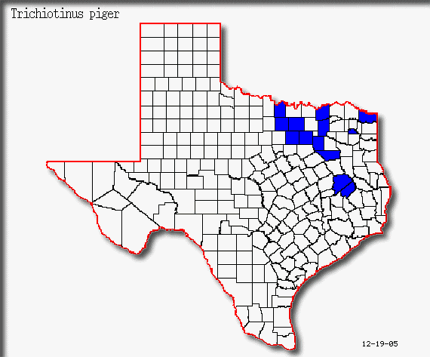
|
Return to Texas Entomology - Compiled by Mike Quinn

|
(Feeding on pollen of Ox-eye Daisy, Chrysanthemum leucanthemum)

|
County Record Data from E.G. Riley, Dec. 2005
Range: Widely distributed in the eastern half of the United States
Adult Activity: May - July per the 71 specimens in the TAMUIC.
Biology: Adults eat the pollen of many species of flowers. When flying, they resemble bees in appearance and in sound.
Similar Species: Eight species of Trichiotinus are found throughout the United States (except the far west) and southern Canada. (Arnett, et.al. 2002).
Texas species:
Trichiotinus lunulatus (Fabricius) - East Texas
Trichiotinus piger (Fabricius) - Northeastern Texas
Trichiotinus texanus (Horn) - See map
Bibliography:
Arnett, R.H., Jr., M.C. Thomas, P.E. Skelley & J.H. Frank. (editors). 2002. American Beetles, Volume II: Polyphaga: Scarabaeoidea through Curculionoidea. CRC Press. 861 pp.
Hoffmann, C.H. 1935. The biology and taxonomy of the genus Trichiotinus (Scarabaeidae; Coleoptera). Entomologica Americana 15 :l33 -214.
Howden, H.F. 1968. A review of the Trichiinae of North and Central America (Coleoptera: Scarabaeidae). Memoires of the Entomological Society of Canada. 54:1-77.
Ratcliffe, B.C. 1991. The Scarab Beetles of Nebraska. Bulletin of the University of Nebraska State Museum 12:1-333.
Riley, E.G. & C.S. Wolfe. 2003. An annotated checklist of the Scarabaeoidea of Texas. Southwestern Entomologist, Supplement, no. 26. 37 pp.
Ritcher, P.O. 1966. White Grubs and Their Allies. A Study of North American Scarabaeoid Larvae. Oregon State University Press, Corvallis. 219 pp.
18 Dec 2005 © Mike Quinn / mike.quinn@tpwd.state.tx.us / Texas Entomology / Texas Beetle Information